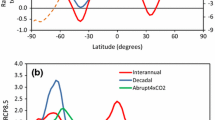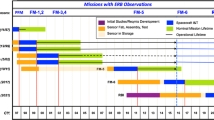Abstract.
Results from climate change simulations indicate a reasonably robust proportionality between global mean radiative forcing and global mean surface air temperature response. The "constant" of proportionality is a measure of the overall strength of climate feedback processes and hence of global climate sensitivity. Geographically, however, temperature response patterns are generally not proportional to, nor do they resemble, their parent forcing patterns. Temperature response patterns, nevertheless, exhibit a remarkable additivity whereby the sum of response patterns for different forcings closely resembles the response pattern for the sum of the forcings.
The geographical distribution of contributions to the climate sensitivity/feedback are obtained diagnostically from simulations with the Canadian Centre for Climate Modelling and Analysis (CCCma) coupled global climate model (GCM). There is positive feedback over high-latitude oceans, over northern land areas, and over the equatorial Pacific. The remaining regions over oceans and tropical land areas exhibit negative feedback. The feedback results are decomposed into components associated with short-and longwave radiative processes and in terms of cloud-free atmosphere/surface and cloud feedbacks. While the geographic pattern of the feedbacks may generally be linked to local processes, all feedback processes display regions of both positive and negative values (except for the solar atmosphere/surface feedback associated with the retreat of ice and snow which is positive) and all vary from place to place so that there is no simple physical picture that operates everywhere. The stable geographical pattern of the feedback is a consequence of the balance between local physical processes rather than the dominance of a particular process.
The feedback results indicate that, to first order, temperature response patterns are determined by the geographical pattern of local feedback processes. The feedback processes act to localize forcing changes and to generate temperature response patterns which depend firstly on the pattern of feedbacks and only secondarily on the pattern of the forcing. The geographical distribution of feedback processes can be regarded as a feature of the climate model (and by inference of the climate system) and not (or only comparatively weak) functions of forcing and climate state. An illustrative model is able to reproduce qualitatively the kinds of forcing/temperature response behavior seen in the CCCma GCM including the quasi-independence of forcing and response patterns, the additivity of temperature response patterns, and the resulting "non-constancy" of the global climate sensitivity.
Similar content being viewed by others
Author information
Authors and Affiliations
Additional information
Electronic Publication
Rights and permissions
About this article
Cite this article
Boer, .G., Yu, .B. Climate sensitivity and response. Climate Dynamics 20, 415–429 (2003). https://doi.org/10.1007/s00382-002-0283-3
Received:
Accepted:
Issue Date:
DOI: https://doi.org/10.1007/s00382-002-0283-3




